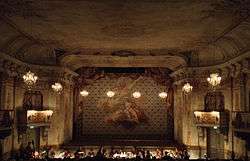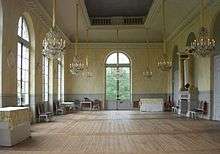Drottningholm Palace Theatre


The Drottningholm Palace Theatre (Swedish: Drottningholms slottsteater) is an opera house located at Drottningholm Palace in Stockholm, Sweden. It is one of the few 18th century theatres in Europe that is still used as a theatre with its original stage machinery.
Currently, the reinvigorated theatre has acquired a growing international reputation as a summer opera festival theatre by focusing on works by Haydn, Handel, Gluck and Mozart and emphasis on authentic performance. The theatre has also had guest performances by the Royal Swedish Opera.
History




The first theatre to be built on the Drottningholm site was designed by the architect Nicodemus Tessin the Elder and completed by Nicodemus Tessin the Younger. The interior was decorated between 1665 and 1703, at first in a heavy, sumptuous baroque style, but later increasingly refined to French patterns. The theatre opened in 1754 and hosted a new troupe of French actors, the Du Londel Troupe (1753-1771), that had been engaged by the court a year earlier. The troupe used the theatre in the summer months to show French and Italian opera for Queen Lovisa Ulrika and her court.
When the original theatre burned down on August 27, 1762, during the performance of a comic opera Queen Lovisa quickly decided to rebuild a theatre for the Drottningholm Palace court, commissioning a replacement opera house by Carl Fredrik Adelcrantz. Work began on the building in 1764, and it eventually included the theatre as well as a complex of smaller chambers off the main auditorium to house members of the court who did not stay at the palace, including Adelcrantz, the master of the revels, the noble chambermaids, the actors and staff of the theatre, and young aristocrats.[1] The building that Adelcrantz created was unusual architecturally in several respects. Most notably, although the theatre was intended to mimic Versailles’s artistic style, the lack of funds of the Swedish Treasury forced a much sparser style.[2] The exterior of the building is very plain in comparison to other palatial theatres, in the style of a country manor with no indication from the exterior that an opera house is inside. The interior, decorated by Adrien Masreliez, uses trompe l'oeil, papier-mâché, and stucco to imitate more expensive materials like marble and gold. The theatre is also architecturally unusual for its shape, since the auditorium is shaped like a T with the two thrones for the reigning monarchs placed in the cross of the T in front of the stage and the rest of the court seated on wooden benches. The stage is also unusually deep, 27 by 57 ft (8.2 by 17.4 m), which helped the set designers to create optical allusions of great distance on the stage.
For scholars, the most important part of the theatre, however, is not the architectural uniqueness of the space, but instead the stage machinery that is a rare surviving example of common stage effects from its time. The machinery for the theatre was possibly designed by the Italian Donato Stopani, although some historians think the designer may have been George Fröman, master builder for the court who studied similar stage machinery when he travelled through Europe in 1755.[3] One of the stage machines that is still intact and in use in the theatre is the chariot-and-pole system, which helps to change scenes quickly by sliding the wings with wheels (“chariots”) on tracks in the floor, controlled by a capstan under the stage (“pole”).[3] The theatre has an unusually large number of wings, with a total of four possible scene changes in a single performance, but the chariot-and-pole system allows a scene change in as little as six seconds.[3] Other machines that are still used in the theatre are purely for special effects, including a wave machine consisting of giant painted corkscrews that are turned to simulate a rough sea, thunder machine to create storm sound effects, and a flying chair which is often used for "deus ex machina" effects. Lighting is controlled by turning metal sconces and their candles toward or away from the stage.
In 1766, the theatre was opened by Queen Lovisa Ulrika, and there were several performances that included court members and the royal family as actors celebrating the occasion.[4] The theatre was used every summer by the court until 1771, when Adolf Frederik died and the French acting troupe he had imported was dismissed. The theatre remained unused until 1777, when Queen Lovisa Ulrika gave it to her son King Gustav III. King Gustaf was deeply interested in the theatre, hiring an acting troupe, and even writing and directing several works at Drottningholm. The theatre that was performed under King Gustaf was a departure from the theatre of his predecessors, since although French and Italian theatre was still performed, he encouraged the use of Swedish stories and language to create a new operatic tradition.[5] He also made some alterations to the theater building itself, adding the Dejeuner Salon that is used as the foyer today. After the assassination of King Gustav III in 1792 (which is the basis of the Giuseppe Verdi opera, Un ballo in maschera), the theatre was used as a storage room for Drottnignholm Palace’s unused furniture.
20th Century restoration and revival
In 1921, Swedish theatre historian Agne Beijer rediscovered Drottningholm Theatre and, with royal permission, preserved what was left of the theatre’s interior and stage machinery. Some small changes were made, including the addition of electric lights, which was designed to flicker like candles, the replacement of the original ropes that moved the machinery, and the substitution replicas for delicate backdrops.[1] Most of the theatre, however, was unchanged from the original design, and much of the stucco work and original wallpaper remains today. The theatre re-opened on 19 August 1922. Until 1935, performances were limited to occasional showcases for visiting scholars, usually including dances performed by the Swedish Ballet School. In 1935, the theatre began to host seasonal performances, starting with three balladoperas by Höpken, Kraus, and Bellman. In 1951, the Royal Swedish Opera became the permanent company performing in Drottningholm Theatre, using the space for their summer performances. In 1953, the Royal Swedish Ballet joined in partnership with the Opera, and the company’s new director, Mary Skeaping, pushed the dancers to revive the 17th and 18th century court ballet style.[6]
Today, a private foundation, the Drottningholm Theatre Museum, funded by government and private grants, runs the theatre, performing operas in the summer months. The operas are often performed by musicians wearing period costume, and the orchestra performs using period or copies of authentic instruments. Most productions demonstrate some of the possible stage effects using the original equipment. The theatre remains a place to train musicians, dancers, and opera singers in Baroque style.
In 1991, the theatre, along with the Drottningholm Palace (the residence of the Swedish royal family), the Chinese Pavilion and the surrounding park, became the first Swedish patrimony to be inscribed in the UNESCO list of World Heritage Sites. Parts of the Palace, the Pavilion and the Theatre are open to the public for tours.
Recent Artistic Directors of the theatre are Arnold Östman (1980–92), Elisabeth Söderström (1993–96), Per-Erik Öhrn (1996-2007). Mark Tatlow (2007-2013). Sofi Lerström, the theatre's Managing Director from 2011 took over as Artistic Director in 2013.
The theatre as featured in Bergman's The Magic Flute
The interior of the theatre was originally scheduled to be featured in Ingmar Bergman's 1975 film version of The Magic Flute. However, according to film historian Peter Cowie's notes for the DVD release of the film, while Bergman wanted to recreate as closely as possible the original 1791 production in the Theater auf der Wieden in Vienna, he had hoped that the film could be shot in the theatre. Introductory exterior shots of the theatre set the scene in the film. However, "the scenery was considered too fragile to accommodate a film crew. So the stage – complete with wings, curtains, and wind machines – was painstakingly copied and erected in the studios of the Swedish Film Institute".[7]
See also
References
Notes
- 1 2 Sauter, Willmar (January 2011). "The Drottningholm Court Theatre and the Historicity of Performance". Nordic Theatre Studies (23): 8–18.
- ↑ Harvey, Anne-Charlotte Hanes (2006). "'Vacker som faux': The Drottningholm Theatre Aesthetic". Tijdschrift Voor Skandinavistiek. 27 (2): 27–53.
- 1 2 3 Mohler, Frank (Winter 1999). "The survival of the mechanized flat wing scene change: the court theaters of Gripsholm, Český Krumlov, and Drottningholm". TD&T: Theatre Design & Technology. 35 (1): 46–56.
- ↑ Beijer, Agne (January 1932). "Gustaf III's Theater restored: Drottningholm Castle, Sweden". American Scandinavian Review. 20: 32–35.
- ↑ Hilleström, Gustaf (1956). Drottningholmsteatern förr och nu. The Drottningholm Theatre-- past and present. Stockholm: Natur och kultur.
- ↑ "Sweden". The International Encyclopedia of Dance. Oxford University Press. Retrieved 8 December 2015.
- ↑ Peter Cowie, "The Magic Flute". Notes on the film followed the DVD release on criterian.com. Retrieved 12 November 2012
External links
- Drottningholm Theatre online at britannica.com
- Theatre website in English
- Animation of the stage machinery created by Appalachian State University
- Video of stage machinery in motion
- Images and Floorplans from the European Route of Historic Theatres
- Unesco Record of the Royal Domain of Drottningholm
Coordinates: 59°19.384′N 17°53.10′E / 59.323067°N 17.88500°E